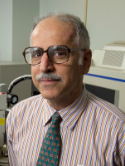| Abstract: |
Sterigmatocystin and aflatoxin are potent mutagens that contaminate foodstuffs stored under conditions that permit fungal growth. These food mycotoxins can be metabolically activated to their epoxides, which subsequently form covalent adducts with DNA and can eventually induce tumor development. We have generated the sterigmatocystin-d(A1-A2-T3-G4-C5-A6-T7-T8) covalent adduct (two sterig-matocystins per duplex) by reacting sterigmatocystin-1, 2-epoxide with the self-complementary d(A-A-T-G-C-A-T-T) duplex and determined its solution structure by the combined application of two-dimensional NMR experiments and molecular dynamics calculations. The self-complementary duplex retains its 2-fold symmetry following covalent adduct formation of sterigmatocystin at the N7position of G4 residues on each strand of the duplex. The H8 proton of [ST]G4 exchanges rapidly with water and resonates at 9.58 ppm due to the presence of the positive charge on the guanine ring following adduct formation. We have assigned the exchangeable and nonexchangeable proton resonances of sterigmatocystin and the duplex in the covalent adduct and identified the intermolecular proton-proton NOEs that define the orientation and mode of binding of the mutagen to duplex DNA. The analysis was aided by intermolecular NOEs between the sterigmatocystin protons with both the major groove and minor groove protons of the DNA. The molecular dynamics calculations were aided by 180 intramolecular nucleic acid constraints, 16 intramolecular sterigmatocystin constraints, and 56 intermolecular distance constraints between sterigmatocystin and the nucleic acid protons in the adduct. The sterigmatocystin chromophore intercalates between the [ST]G4∙C5 and T3-A6 base pairs and stacks predominantly over the modified guanine ring in the adduct duplex. The overall conformation of the DNA remains right-handed on adduct formation with unwinding of the helix, as well as widening of the minor groove. Parallel NMR studies on the sterigmatocystin-d(A1-A2-A3-G4-C5-T6-T7-T8) covalent adduct (two sterigmatocystins per duplex) provide supportive evidence that the mutagen covalently adducts the N7position of G4 and its chromophore intercalates to the 5ʹ side of the guanine and stacks over it. The present NMR-molecular dynamics studies that define a detailed structure for the sterigmatocystin-DNA adduct support key structural conclusions proposed previously on the basis of a qualitative analysis of NMR parameters for the adduct formed by the related food mutagen aflatoxin B1 and DNA [Gopalakrishnan, S., Harris, T.M., & Stone, M.P. (1990) Biochemistry 29, 10438-10448]. © 1992, American Chemical Society. All rights reserved. |
| Keywords: |
binding affinity; magnetic resonance spectroscopy; base sequence; binding site; base pairing; dna adduct; hydrogen bonding; protons; solutions; molecular structure; chromatography, high pressure liquid; nucleic acid conformation; dna binding; structure analysis; molecular conformation; proton nuclear magnetic resonance; dna denaturation; oligodeoxyribonucleotides; dna conformation; base composition; mutagen testing; aflatoxin; priority journal; article; toxin analysis; support, non-u.s. gov't; support, u.s. gov't, p.h.s.; chemistry, physical; sterigmatocystin
|



